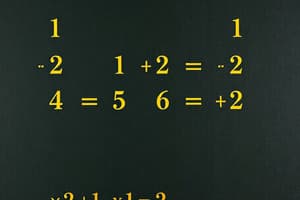Podcast
Questions and Answers
What is the primary purpose of exponents in mathematics?
What is the primary purpose of exponents in mathematics?
- To perform addition operations
- To solve equations
- To calculate area
- To represent repeated multiplication (correct)
The surface area of a three-dimensional object is the sum of the areas of its surfaces.
The surface area of a three-dimensional object is the sum of the areas of its surfaces.
True (A)
What is the formula to calculate the area of a rectangle?
What is the formula to calculate the area of a rectangle?
length x width
A quadratic equation is an equation where the highest power of the variable is __________.
A quadratic equation is an equation where the highest power of the variable is __________.
Match the following geometric shapes with their corresponding formulas for area:
Match the following geometric shapes with their corresponding formulas for area:
Which of the following statements about linear equations is true?
Which of the following statements about linear equations is true?
The perimeter of a shape is calculated by multiplying its area by two.
The perimeter of a shape is calculated by multiplying its area by two.
The process of breaking down a polynomial into simpler expressions is called __________.
The process of breaking down a polynomial into simpler expressions is called __________.
Flashcards
Basic Arithmetic Operations
Basic Arithmetic Operations
Operations like addition, subtraction, multiplication, and division form the basis of all mathematical calculations. Understanding these is essential for solving more complex problems involving numbers.
Order of Operations (PEMDAS/BODMAS)
Order of Operations (PEMDAS/BODMAS)
The order in which mathematical operations are performed. It dictates the priority for calculations, ensuring consistent results.
Sets and Numbers
Sets and Numbers
Collections of numbers with specific characteristics. Understanding these sets is crucial for working with numbers in algebra and beyond.
Variables
Variables
Signup and view all the flashcards
Algebraic Expressions
Algebraic Expressions
Signup and view all the flashcards
Equations
Equations
Signup and view all the flashcards
Linear Equations
Linear Equations
Signup and view all the flashcards
Systems of Equations
Systems of Equations
Signup and view all the flashcards
Study Notes
Math Fundamentals
- Basic Arithmetic Operations: Addition, subtraction, multiplication, and division are fundamental mathematical operations. Understanding these is crucial for more complex problems.
- Order of Operations (PEMDAS/BODMAS): Parentheses/Brackets, Exponents/Orders, Multiplication and Division (left to right), Addition and Subtraction (left to right) determines the calculation sequence.
- Sets and Numbers: Different types of numbers (natural, integers, rational, irrational, real) have unique characteristics. Understanding these sets is vital for algebra and mathematics.
Algebra
- Variables and Expressions: Letters (variables) represent unknown quantities in algebra. Expressions combine variables, numbers, and operators.
- Equations and Inequalities: Equations show equality, inequalities demonstrate relationships like greater than or less than. Solving equations finds the variable's value.
- Linear Equations: Equations with a variable's highest power of 1, commonly graphed as straight lines. They show relationships between two variables.
- Systems of Equations: Multiple linear equations are solved simultaneously to find values that satisfy all equations.
- Polynomials: Expressions with variables raised to non-negative integer powers, combined with coefficients and constants.
- Factoring: Simplifying polynomials by breaking them down into simpler expressions.
- Quadratic Equations: Equations with a variable's highest power of 2. Solutions can be found via the quadratic formula or factoring.
Mensuration
- Geometric Shapes: Understanding shape properties (triangles, squares, circles, cubes, cylinders) is crucial.
- Area: Enclosed two-dimensional space measured using formulas specific to shapes.
- Perimeter: The total distance around a two-dimensional shape.
- Volume: The space occupied by a three-dimensional object, calculated using specific formulas.
- Surface Area: The combined area of all surfaces on a three-dimensional object.
Power and Exponents
- Exponents: A concise way to represent repeated multiplication (e.g., 23 = 2 x 2 x 2).
- Base: The number being repeatedly multiplied.
- Exponent: The number showing how many times the base is multiplied by itself.
- Laws of Exponents: Rules for simplifying and solving exponent expressions (multiplication, division, powers of powers, negative exponents).
- Zero Exponent: Any non-zero number to the power of zero equals 1.
- Negative Exponents: Negative exponents represent reciprocals (1/base|exponent|).
- Scientific Notation: A method expressing very large or very small numbers using powers of 10.
- Applications of Powers and Exponents: Used in numerous scientific and mathematical contexts (compound interest, growth modeling, measuring very large or very small quantities).
Studying That Suits You
Use AI to generate personalized quizzes and flashcards to suit your learning preferences.




